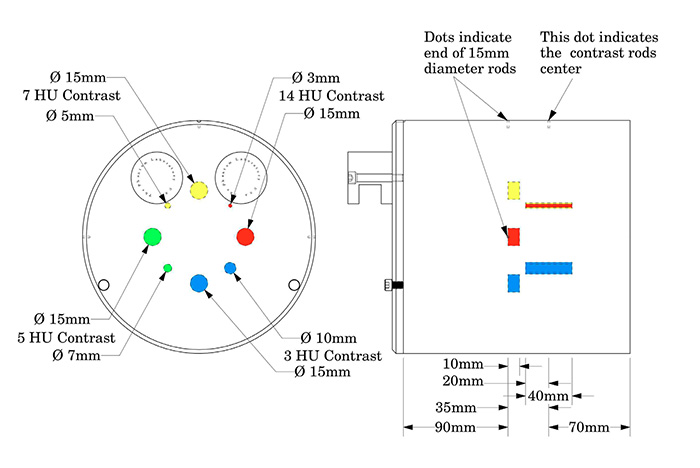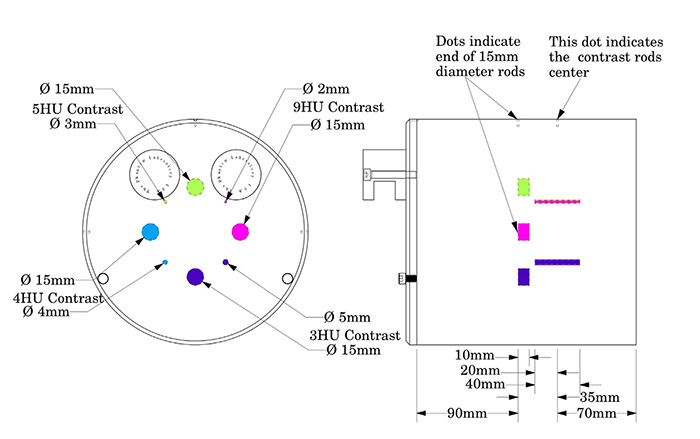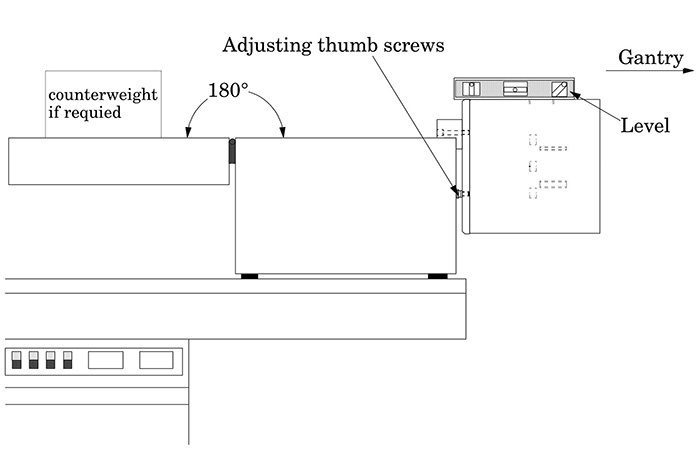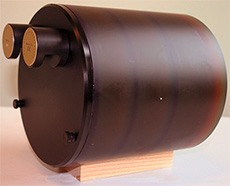CCT189 and CCT191 MITA CT IQ Low Contrast Phantom - Phantom Laboratory
IntroductionThe Phantom Laboratory, Incorporated developed the CCT189 and CCT191 Phantom to address the design criteria presented by the MITA CT IQ Task Group in 2013. These designs were selected by the MITA committee to replace the CCT183 phantom.
Indications for UseThe CCT189 and CCT191 MITA IQ LC Phantoms are designed for performing low contrast measurements as defined by the MITA CT IQ Task Group. The CCT189 is designed for body imaging low contrast evaluations and the CCT191 is designed for head imaging low contrast evaluations.
Both phantoms have eight contrast rods evaluated at manufacturing to be within 0.05% density or ±0.5 HU of target values. The symmetric positioning of the contrast object make these phantoms ideal for conducting forced choice and rating scale experiments for evaluating reconstruction algorithms.
Schematic Drawing CCT189 Low Contrast Body PhantomThe CCT189 Phantom has eight contrast rods. Four of the contrast rods are 40mm long, and each of these rods have different diameters and nominal contrasts. Samples from each selected batch of contrast rods are tested with multiple scans on our in house CT scanner. The scans of the contrast rods are analyzed through automated analysis. While these contrasts are measured to be within .05% of target values for more precise evaluation of your phantom we recommend averaging of multiple scans.
The nominal contrast values and diameters are 14HU contrast with 3mm diameter, 7HU contrast with 5mm diameter, 5HU contrast with 7mm diameter and 3HU contrast with 10mm diameter (HU referring to Hounsfield Units or CT numbers). For each 40mm long contrast rod there is a corresponding 10mm long, 15mm diameter contrast rod. To assure contrast consistency the 40mm rods and the 10mm rods of each contrast come from the same casting batch.
The phantom has four alignment dots which are helpful in positioning the phantom. There are three dots that define the plane aligned with the mount end of the 10mm long, 15mm diameter contrast rods. One of these dots is on the top and the other two are on the sides of the phantom. The fourth dot is also on the top of the phantom and aligns with the center of the 40mm contrast rods.

CCT189 Low Contrast Body Phantom Sketch
Schematic Drawing CCT191 Low Contrast Body Phantom
The CCT191 Phantom has eight contrast rods. Four of the contrast rods are 40mm long, and each of these rods have different diameters and nominal contrasts. Samples from each selected batch of contrast rods are tested with multiple scans on our in house CT scanner. The scans of the contrast rods are analyzed through automated analysis. While these contrasts are measured to be within .05% of target values for more precise evaluation of your phantom we recommend averaging of multiple scans.
The nominal contrast values and diameters are 9HU contrast with 2mm diameter, 5HU contrast with 3mm diameter, 4HU contrast with 4mm diameter and 3HU contrast with 5mm diameter (HU referring to Hounsfield Units or CT numbers). For each 40mm long contrast rod there is a corresponding 10mm long, 15mm diameter contrast rod. To assure contrast consistency the 40mm rods and the 10mm rods of each contrast come from the same casting batch.
The phantom has four alignment dots which are helpful in positioning the phantom. There are three dots that define the plane aligned with the mount end of the 10mm long, 15mm diameter contrast rods. One of these dots is on the top and the other two are on the sides of the phantom. The fourth dot is also on the top of the phantom and aligns with the center of the 40mm contrast rods.

CCT191 Low Contrast Body Phantom Sketch
Scanning Alignment
The CCT189 and CCT191 Phantoms are equiped with a Catphan® case and mount. Place the phantom case on the gantry end of the table with the box hinges away from the gantry. It is best to place the box directly on the table and not on the table pads.
Open the box, rotating the lid back 180°. If you are using an annulus, additional weight will need to be placed in the box to counterweigh the phantom. The patient straps can be used for additional stability.
Remove the phantom from the box and hang the Catphan® from the gantry end of the box. Make sure the box is stable with the weight of the phantom and is adequately counterweighed to prevent tipping.
Use the level and adjusting thumb screws to level the Catphan®. Once the phantom is level, slide the phantom along the end of the box to align the section center dots on the top of the phantom with the x axis alignment light.
Use the table height and indexing drives to position the phantom.

- 14HU contrast, 3mm diameter x 40mm length and 15mm diameter x 10mm length
- 7HU contrast, 5mm diameter x 40mm length and 15mm diameter x 10mm length
- 5HU contrast, 7mm diameter x 40mm length and 15mm diameter x 10mm length
- 3HU contrast, 10mm diameter x 40mm length and 15mm diameter x 10mm length
- 9HU contrast, 3mm diameter x 40mm length and 15mm diameter x 10mm length
- 7HU contrast, 5mm diameter x 40mm length and 15mm diameter x 10mm length
- 5HU contrast, 7mm diameter x 40mm length and 15mm diameter x 10mm length
- 3HU contrast, 10mm diameter x 40mm length and 15mm diameter x 10mm length



